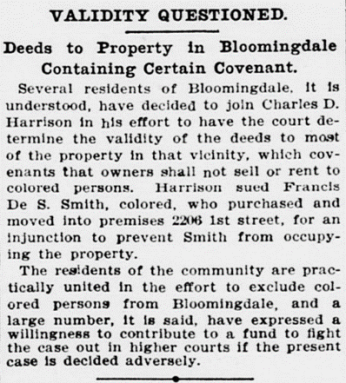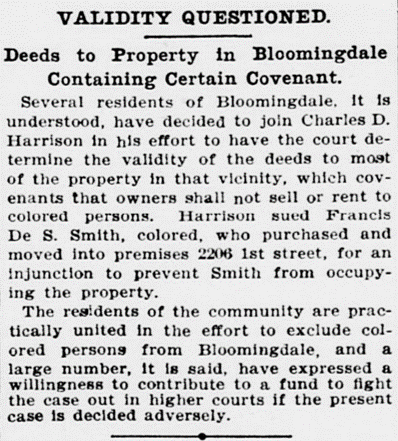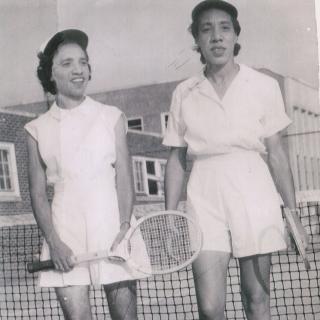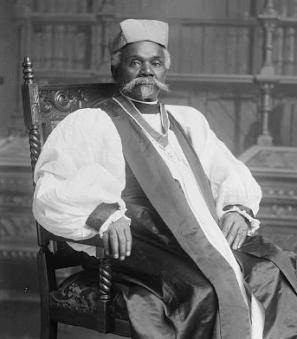The Battle for Bryant Street: How A Black D.C. Family Helped Overturn Racial Covenants Nationwide
For several decades, equilibrium had reigned on the 100 block of Bryant Street NW. By the mid 1940s, 31 houses stood on the quiet road, which passes below the McMillan Reservoir near Howard University. 11 homes were owned by Black families. The other 20, however, were “protected.” Each of their deeds declared that “the sale of the house to anyone of the Negro race” was expressly prohibited.[1] Their White owners liked it that way.
But in 1944, an unlikely team coalesced to tear down the racist barriers keeping African Americans from moving into the neighborhood. They included ordinary working families, a flamboyant realtor, and leading figures from the burgeoning Civil Rights Movement. Together, they would win Black homeowners not just access to Bryant Street, but every neighborhood in the United States.
The struggle began in May 1944, when Francis Ryan put his home at 116 Bryant Street on the market. The Ryan residence was one of the 20 properties that were theoretically restricted against any African American buyer. But the first offer Ryan received came from James Hurd, a successful welder, and his wife Mary. The fair-skinned couple had spent years looking for a house amid wartime overcrowding in Washington, and were thrilled to find an opening on Bryant Street. Though James and Mary were regarded as Black, Ryan sold to them anyway.[2]
By purchasing their home, the Hurds ran up against the nationwide system of racial covenants. These clauses banned the sale of property to certain racial groups, almost always Black people but often Jewish, Asian, Hispanic, and other nonwhite Americans too. In the 1920s, buyers and lenders came to see segregation as necessary to maintain value and desirability, so covenants became a coveted amenity. When the federal government powered into the housing market during the New Deal, it also embraced racial restrictions. The Federal Housing Administration believed that covenants protected property value from the threat of integration, and often required builders to adopt them in order to receive financing. By the time James and Mary Hurd were looking for a home, nearly every new development in the country barred families like them.[3]
When the Hurds moved in, a network of covenant defenders mobilized to push them out. As James and Mary carried in their belongings, they received a visit from Lena Hodge, a white woman who had lived on Bryant Street for three decades. She had accepted when Syrian and Italian immigrants had moved in around her, but she drew the line at Black people. Hodge had successfully intimidated a different African American family from taking up residence on 152 Bryant Street just weeks earlier. When she saw the Hurds, she warned them that they would soon be moving back out.[4]
Almost immediately, James received a call and letter from Henry Gilligan, Washington’s leading covenant lawyer. Gilligan, a friend of Hodge’s who lived just around the corner on 2304 First Street NW, was an ardent segregationist. He believed that any degree of integration would cause the “destruction of white communities,” which shaped his tenure on the D.C. Board of Education and role as president of North Capitol Citizens Association. Gilligan told James Hurd that if the couple did not leave, he would use the courts to drive them out as he had other Black families around the city. As James later said to Gilligan, “you talked [to me] like you was talking to a dog.”[5]
As an anxious person, James considered backing down, but Mary would not have it. She told him that she “liked the place and wasn’t going to move anywhere.”[6] Luckily, they would not have to fight alone. When they contacted the National Association for the Advancement of Colored People (NAACP), the Hurds were matched with Charles Hamilton Houston. A graduate of Harvard Law School, Houston was the nation’s leading African American attorney and the mentor of Thurgood Marshall. With housing scarcity stifling Washington’s Black community, he set his sights on racial covenants. Though Houston successfully integrated Adams Street, just one block behind Bryant, he had just suffered a stinging defeat while defending Carla Mays, a Black federal employee who was forced out of the covenanted home she purchased. By taking on the Hurd case, Houston wanted to avenge Mays and settle the covenant issue once and for all.[7]
The Hurds also received support from a more unusual source. Raphael Urciolo, a successful realtor with a PhD in linguistics, made his career selling covenanted homes to Black families, which got him expelled from the Washington Real Estate Board. Urciolo was always clear that his chief goal was “making as much money as you can possibly make.” He accomplished this by selling homes at a markup to Black buyers, who were hemmed in by an artificially scarce housing market. But Urciolo also cared about the cause. He thought covenants were racist and proudly told critics that “I have no interest whatsoever in a man’s color, only what he is.” Conveniently, Urciolo owned houses on Bryant Street, and soon after the Hurd family moved in, he sold three to Black families. This would be his fight too.[8]
The Hurds spent a doubtlessly uncomfortable year living in 116 Bryant before their case reached the courts, where Hodge and Gilligan’s cases against the Hurds and Urciolo were merged into one. Leading the defense, Charles Houston took aim at covenants and the whole notion of biological race. James and Mary Hurd were both light-skinned, and Houston argued that neither could be proven to be Black. To support his claims, he called leading anthropologists to testify that it was impossible to determine whether James was African American or a Mohawk Native American like he claimed in court. To pair with his constitutional arguments, Houston also exposed the hollow racism of residents who testified against the Hurds, for instance, getting Lena Hodge to admit that she would rather live next to a White criminal than a Black congressman “because he is white and I am white.”
The District Court was unmoved. Judge F. Dickinson Letts, who resided in a home with racial covenants, ordered the Hurds and the Black families who had bought from Urciolo to vacate their properties.[9] Houston appealed, but in May 1947 the Court of Appeals again declared the covenants legally valid. However, not all of its members agreed. Henry Edgerton, one of the nation’s foremost liberal jurists, penned a passionate dissent. He denounced covenants and the “ghetto system they enforce,” writing that having a court “take away appellants’ homes by force because they are Negroes” obviously violated the Constitution and the new Charter of the United Nations.[10]
Edgerton’s friends on the Supreme Court took notice. In October, they agreed to hear the case alongside Shelley v. Kramer, an anti-covenant case argued by Houston’s protege Thurgood Marshall. With the future of covenants at stake, groups around the country got involved. The Washington Post reported that the Court “got one of the heaviest files of briefs in its history.” Real estate groups and property owners’ associations demanded that covenants remain, lest their home values plummet as Black people moved in. Civil Rights, labor, religious groups argued the opposite, calling covenants an affront to democracy.[11]
President Harry Truman agreed. He instructed Solicitor General Philip B. Perlman to join the case and speak before the Court. Arguing before only six justices (the rest having recused themselves because they lived in racially restricted houses), Perlman declared that covenants “should be relegated to the limbo of other things as dead as slavery.”[12] The Court concurred. In a unanimous ruling, the justices declared that while covenants on their own were not illegal, no court could enforce them without violating the Constitution. To settle the Hurd portion of the combined case, the justices revived the long-ignored Civil Rights Act of 1866, passed after the Civil War, which guaranteed that every citizen had the same right to purchase property. The Hurds, and families like them around the country, could keep their homes.[13]
Black residents on Bryant Street and beyond were elated. 87-year-old Paul R. Stewart, who had lived in a non-covenanted house on the block for years, yelled “Thank God!” after a Washington Post reporter screamed the good news into his all-but-deaf ear. Fulton Matthews, a Bryant Street resident who worked at the Pentagon, was just as overjoyed. “I knew it couldn’t stand that way,” he said. “This is America, brother.” Around the country, African Americans reacted with similar enthusiasm. [14]The Black-run Chicago Defender called it “the most outstanding decision affecting Negroes to be won in the court in the last half century.”[15]
But not everyone was so happy. White homeowners in D.C. were furious. Irma Purdue of 146 Bryant St declared “I’m putting up the for-sale sign tomorrow.” Many of her white neighbors offered similar laments to journalists who flooded the block. Washington citizens’ groups immediately began mobilizing to come up with new legal strategies for preserving segregation, including placing their homes in a common trust that would require community approval to sell from. Gilbert C. Vincent, president of the National Gateway Group, promised that “we will find ways and means to throw it back into the Supreme Court and they will reverse their decision. There will once again be white supremacy.”[16]
In the short term, he was almost right. The Federal Housing Administration disregarded the decision for two years by continuing to support racial restrictions. Even when covenants disappeared, the racial boundaries they created had become inseparable from how home buyers, banks, and realtors understood real estate value.[17]
But for families like James and Mary Hurd, the impact of their victory was enormous. Black homebuyers could now access every part of Washington, and the overcrowding that had defined the city’s African American community for decades faded away. Through the courage and sacrifice of the Hurds and those who supported them, the promise of “Chocolate City” inched closer to reality.
Footnotes
- ^ Dillard Stokes, “Covenant Case Arguments End; Decision Unlikely for Months,” Washington Post, January 17, 1948, 1. Dillard Stokes, “High Court Voids Racial Ban in Realty Transactions,” Washington Post, May 4, 1948, 1, 3.
- ^ Stokes, “High Court Voids.” Jeffrey D Gonda, Unjust Deeds: The Restrictive Covenant Cases and the Making of the Civil Rights Movement, (Chapel Hill: The University of North Carolina Press, 2015), 40.
- ^ For more on the national rise of racial covenants, see Richard Rothstein, The Color of Law: A Forgotten History of How Our Government Segregated America, (New York: Liveright Publishing Corporation, 2017) and David Freund, Colored Property: State Policy and White Racial Politics in Suburban America, (Chicago: University of Chicago Press, 2010), 49-98, 116-117, 130-133.
- ^ Clement E. Vose, Caucasians Only: The Supreme Court, the NAACP, and the Restrictive Covenant Cases, (Berkeley: University of California Press, 1959), 82-84. Gonda, Unjust Deeds, 46-49.
- ^ Stokes, “Covenant Case Arguments.” Robert K. Walsh, “The Covenants Issue,” Evening Star, October 07, 1947, A8. Vose, Caucasians Only, 74, 78-81. Gonda, Unjust Deeds, 47-48, 90.
- ^ Gonda, Unjust Deeds, 51.
- ^ Vose, Caucasians Only, 75, 84-86. Gonda, Unjust Deeds, 51, 77-79.
- ^ J.Y. Smith, “Lawyer Raphael G. Urciolo Dies; Fought Racially Biased Covenants,” Washington Post, October 7, 1994, D4. Stokes, “High Court Voids.” Vose, Caucasians Only, 80-81. Gonda, Unjust Deeds, 41.
- ^ Vose, Caucasians Only, 84-93. Gonda, Unjust Deeds, 77-83.
- ^ W.G. Pollard, “Covenant Excluding Negroes is Upheld by Appeals Court,” Evening Star, May 26, 1947, A2. Hurd v. Hodge, Nos. 9196, 9197, United States Court of Appeals District of Columbia (May 1947). Vose, Caucasians Only, 95. Gonda, Unjust Deeds, 101.
- ^ “Stokes, “High Court Voids.” “Lawyers’ Guild to Ask Clark to File Brief Opposing Covenants,” Evening Star, October 02, 1947, A25. Robert K. Walsh, “The Covenants Issue,” Evening Star, October 07, 1947, A8. “Brief Asks High Court to Outlaw Covenant Ban on Colored Buyers,” Evening Star, November 20, 1947, A24.
- ^ “3 Justices Step Out of Covenants Case,” Washington Post, January 16, 1948, 30.
- ^ Shelley v. Kraemer, 334 U.S. 1 (1948). Hurd v. Hodge 334 U.S. 24 (1948). Robert K. Walsh, “Covenants on Voluntary Basis as Court Bars Enforcement,” Evening Star, May 04, 1948, A1, A4. “Stokes, “High Court Voids.”
- ^ Frank Wilder, “Race Covenant Rule Disappoints Many,” Washington Post, May 4, 1948, 3. “Covenant Ruling Reaction Runs from Silence to Jubilation,” Evening Star, May 04, 1948, A4.
- ^ Venice Spraggs, “Supreme Court Kills Evil Covenants,” Chicago Defender, May 8, 1948, 1.
- ^ Wilder, “Race Covenant.” “Covenant Ruling,” Evening Star.
- ^ Kenneth T. Jackson, Crabgrass Frontier: The Suburbanization of the United States, (New York: Oxford University Press, 1985), 208. Freund, Colored Property, 32.




![This integrated classroom at Anacostia High School is the culmination of a seven year struggle against DC's segregated school system. [Source: LOC] Integrated classroom at Anacostia High School](/sites/default/files/styles/crop_320x320/public/AHS%20Class_0.jpg?itok=GNxSJFox)


![Sketch of the mythical fuan by Pearson Scott Foresman. [Source: Wikipedia]](/sites/default/files/styles/crop_320x320/public/2023-10/Goatman_Wikipedia_Faun_2_%28PSF%29.png?h=64a074ff&itok=C9Qh-PE1)












